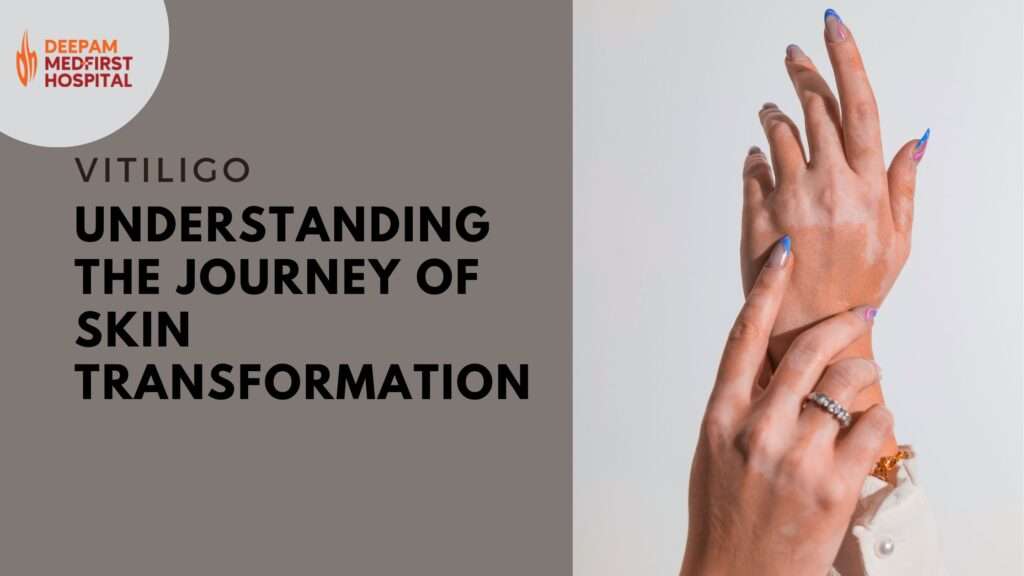Introduction
Vitiligo is a chronic skin condition characterized by the loss of pigmentation in patches of the skin. It affects millions of people worldwide, causing not only physical changes but also emotional and psychological challenges. This blog post aims to provide a comprehensive overview of the, covering its causes, symptoms, and available treatments.
What is Vitiligo?
It occurs when melanocytes, the cells responsible for producing skin pigment (melanin), are destroyed. This leads to the appearance of white patches on the skin. These patches can develop anywhere on the body, including the face, hands, feet, and even inside the mouth and nose.
Causes of Vitiligo
The exact cause of is not fully understood, but several factors are believed to contribute to the condition
Autoimmune Response
It is often considered an autoimmune disorder, where the body’s immune system mistakenly attacks and destroys melanocytes.
Genetics
There is a higher likelihood of developing vitiligo if there is a family history of the condition.
Environmental Triggers
Factors such as sunburn, stress, or exposure to certain chemicals might trigger or exacerbate vitiligo in predisposed individuals.
Symptoms of Vitiligo
The primary symptom of the appearance of white patches on the skin. These patches are usually more noticeable in areas exposed to the sun, such as the face, arms, and legs. Other symptoms may include
Premature whitening or graying of hair on the scalp, eyelashes, eyebrows, or beard
Loss of color in the tissues inside the mouth and nose
Change in color of the retina (inner layer of the eyeball)
Types of Vitiligo
It can be classified into several types based on the pattern and extent of depigmentation
Generalized
- This is the most common type.
- Depigmented patches are widespread across the body.
- Often symmetrical, affecting both sides of the body similarly.
Segmental
- Depigmented patches appear on one side or part of the body.
- Often occurs at an early age and progresses for a few years before stabilizing.
- Less common than generalized vitiligo.
Focal
- Limited to a few areas without a specific pattern.
- Often stable without spreading to other areas.
Acrofacial
- Affects the extremities (hands and feet) and face.
- Depigmented patches appear on the tips of fingers and toes, around the mouth, eyes, and ears.
Mucosal
- It affects the mucous membranes of the body.
- It is commonly affects the lips and genital areas.
Universal
- Extensive depigmentation covering more than 80-90% of the body.
- Rare and involves widespread loss of pigment.
Trichome
- Characterized by a white or depigmented center, followed by an area of lighter pigmentation, then normal skin.
- Creates a three-color pattern.
Mixed
- Combines features of segmental and non-segmental vitiligo.
- Patches can appear both symmetrically and asymmetrically.
Diagnosis and Treatment
Diagnosing It involves a physical examination and a review of medical history. A dermatologist may use a special lamp (Wood’s lamp) to identify the patches more clearly.
While there is no cure for It, several treatments can help manage the condition and improve the appearance of the skin
Topical Steroids
Corticosteroid creams may help restore some pigmentation in small areas.
Phototherapy
Exposure to ultraviolet light (UVB) can stimulate melanocyte production.
Depigmentation
For extensive It, depigmenting the unaffected skin to match the white patches might be an option.
Surgery
Skin grafting and tattooing are surgical options for those with stable It
Camouflage
Makeup and self-tanners can help conceal the patches.
Conclusion
Vitiligo is a complex condition with no one-size-fits-all solution. Understanding its causes, symptoms, and available treatments can help individuals better manage the condition and lead fulfilling lives. If you or someone you know is affected by vitiligo, remember that support and resources are available to help navigate this journey.

